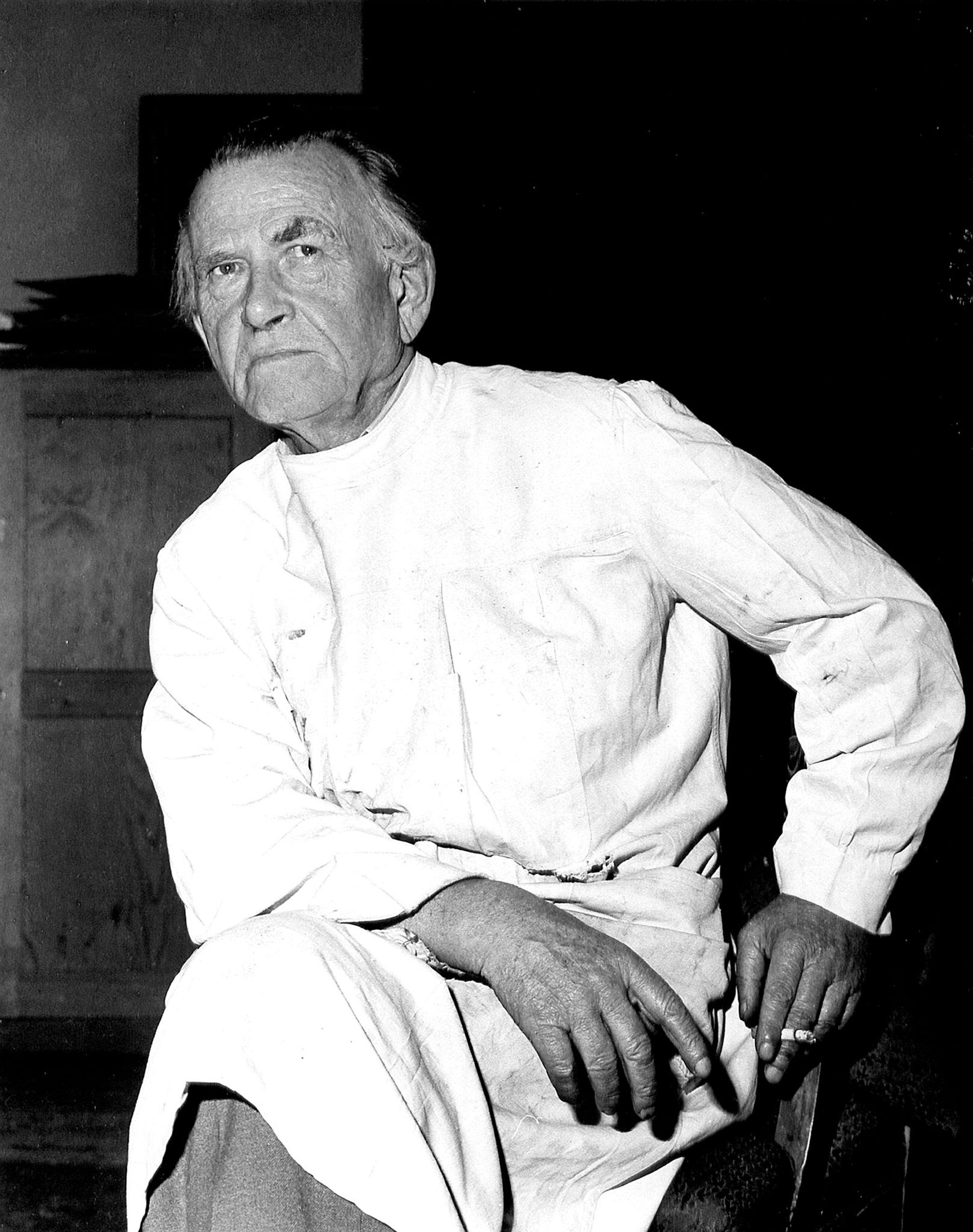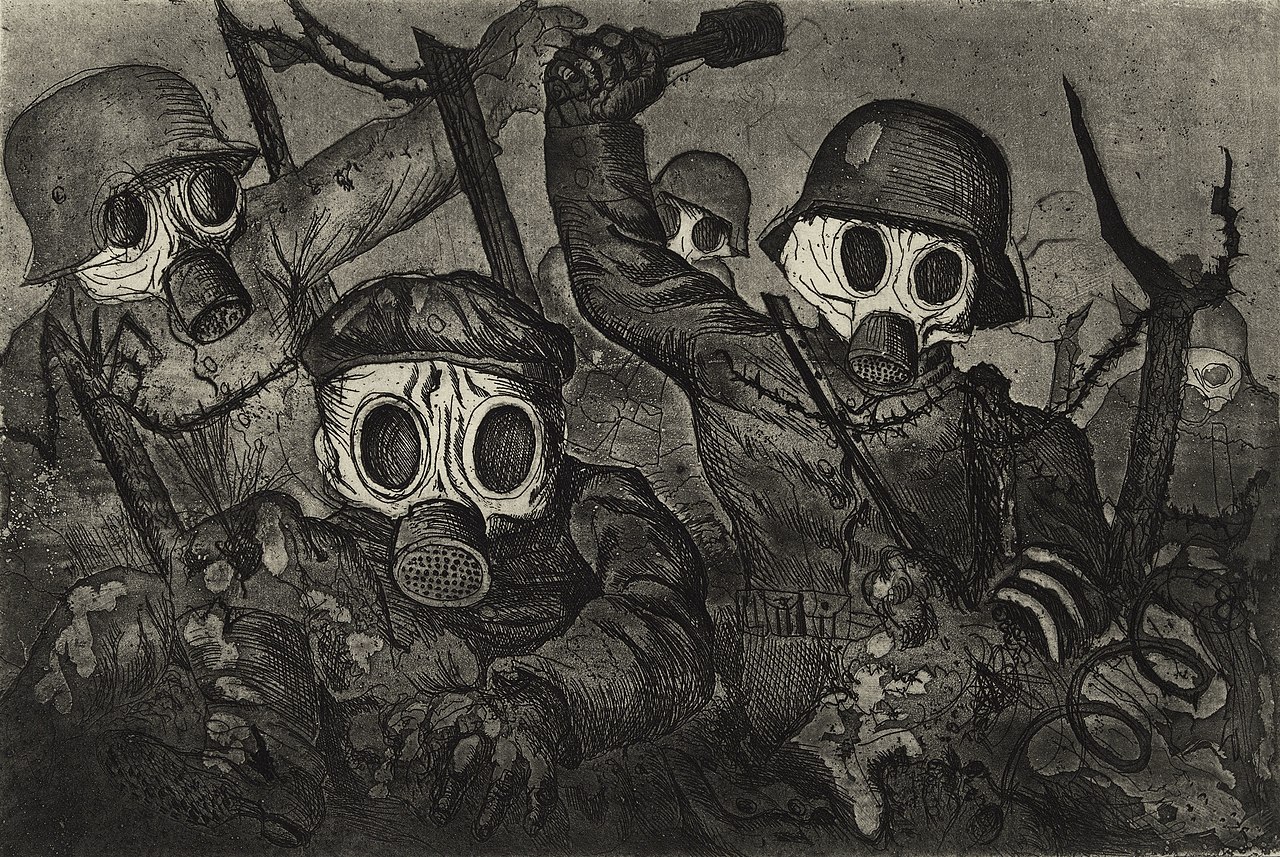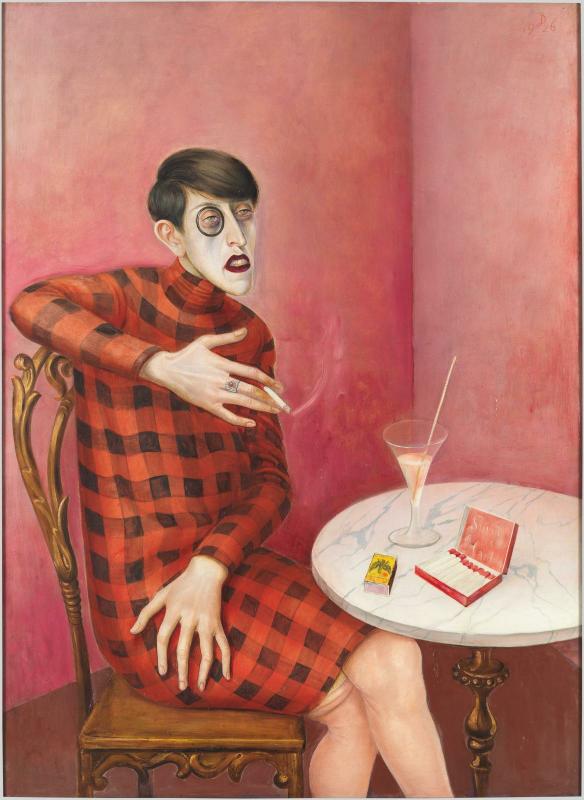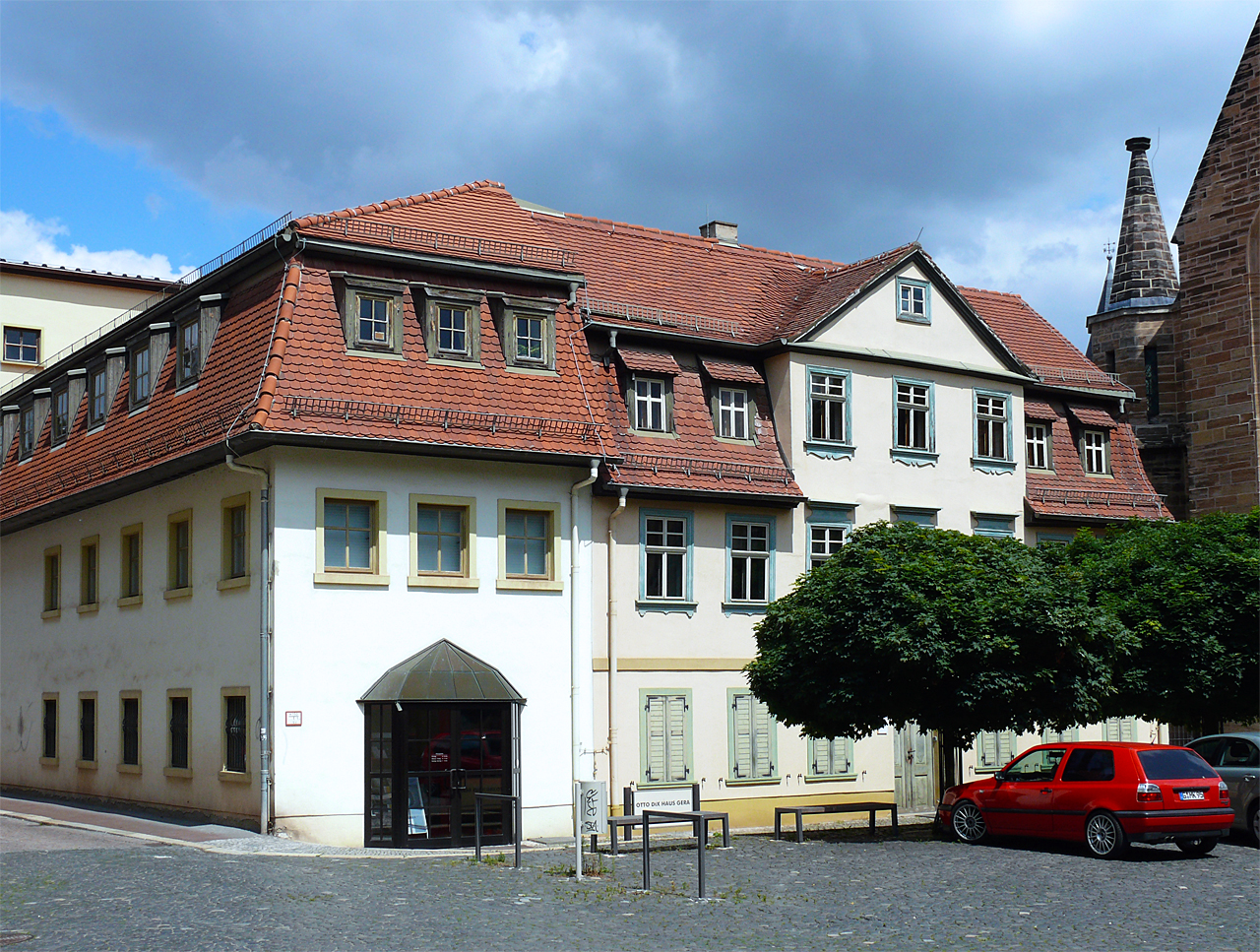
オットー・ディクス
Otto Dix, 1891-1969

☆ ヴィルヘルム・ハインリヒ・オットー・ディクス(ドイツ語: [ˈɪˈ haɪˈˈʔɔˈ ˈdɪks]; 1891年12月2日 - 1969年7月25日)[1]はドイツの画家、版画家で、ワイマール共和国時代のドイツ社会と戦争の残虐性を冷酷かつ厳しく写実的に描いたことで知られ る。ジョージ・グロッシュやマックス・ベックマンと並び、新古典主義の最も重要な画家の一人と広く考えられている
| Wilhelm Heinrich Otto Dix
(German: [ˈvɪlhɛlm ˈhaɪnʁɪç ˈʔɔtoː ˈdɪks]; 2 December 1891 – 25 July
1969)[1] was a German painter and printmaker, noted for his ruthless
and harshly realistic depictions of German society during the Weimar
Republic and the brutality of war. Along with George Grosz and Max
Beckmann, he is widely considered one of the most important artists of
the Neue Sachlichkeit.[2] |
ヴィ
ルヘルム・ハインリヒ・オットー・ディクス(ドイツ語: [ˈɪˈ haɪˈˈʔɔˈ ˈdɪks]; 1891年12月2日 -
1969年7月25日)[1]はドイツの画家、版画家で、ワイマール共和国時代のドイツ社会と戦争の残虐性を冷酷かつ厳しく写実的に描いたことで知られ
る。ジョージ・グロッシュやマックス・ベックマンと並び、新古典主義の最も重要な画家の一人と広く考えられている[2]。 |
| Biography Early life and education Otto Dix was born in Untermhaus, Germany, now a part of the city of Gera, Thuringia. The eldest son of Franz Dix, an iron foundry worker, and Louise, a seamstress[3] who had written poetry in her youth, he was exposed to art from an early age.[4] The hours he spent in the studio of his cousin, Fritz Amann, who was a painter, were decisive in forming young Otto's ambition to be an artist; he received additional encouragement from his primary school teacher.[4] Between 1906 and 1910, he served an apprenticeship with painter Carl Senff, and began painting his first landscapes. In 1910, he entered the Kunstgewerbeschule in Dresden, now the Dresden Academy of Fine Arts, where Richard Guhr was among his teachers. At that time the school was not a school for the fine arts but rather an academy that concentrated on applied arts and crafts.[5] The majority of Dix's early works concentrated on landscapes and portraits which were done in a stylized realism that later shifted to expressionism.[6] |
略歴 生い立ちと教育 オットー・ディックスはドイツのウンタームハウス(現在はテューリンゲン州ゲラ市の一部)で生まれた。鋳物工場で働くフランツ・ディックスと、若い頃に詩 を書いていた裁縫師のルイーゼ[3]の長男として生まれ、幼い頃から芸術に親しんだ[4]。従兄弟で画家のフリッツ・アマンのアトリエで過ごした時間は、 幼いオットーが画家を志す決定的なきっかけとなった。1910年、ドレスデンの美術学校(現在のドレスデン美術アカデミー)に入学。当時の同校は美術学校 ではなく、応用美術と工芸に特化したアカデミーであった[5]。 ディックスの初期の作品の大半は、風景画と肖像画に集中しており、それらは様式化されたリアリズムで描かれ、後に表現主義へと移行した[6]。 |
World War I service Stormtroopers Advancing Under Gas, etching and aquatint by Otto Dix, 1924 When the First World War erupted, Dix volunteered for the German Army. He was assigned to a field artillery regiment in Dresden.[7] In the autumn of 1915 he was assigned as a non-commissioned officer of a machine-gun unit on the Western front and took part in the Battle of the Somme. In November 1917, his unit was transferred to the Eastern front until the end of hostilities with Russia, and in February 1918 he was stationed in Flanders. Back on the western front, he fought in the German spring offensive. He earned the Iron Cross, 2nd class, and reached the rank of Vizefeldwebel. In August of that year he was wounded in the neck, and shortly after he took pilot training lessons. He took part in an anti-aircraft course in Tongern, was promoted to Vizefeldwebel and after passing the medical tests transferred to Aviation Replacement Unit Schneidemühl in Posen. He was discharged from service on 22 December 1918 and was home for Christmas.[8] Dix was profoundly affected by the sights of the war, and later described a recurring nightmare in which he crawled through destroyed houses. He represented his traumatic experiences in many subsequent works, including a portfolio of fifty etchings called Der Krieg, published in 1924.[9] Subsequently, he referred to the war again in The War Triptych, painted from 1929 to 1932. |
第一次世界大戦 ガス下で前進するストームトルーパー、エッチングとアクアチント、オットー・ディックス作、1924年 第一次世界大戦が勃発すると、ディクスはドイツ軍に志願した。1915年秋、彼は西部戦線の機関銃部隊の下士官として配属され、ソンムの戦いに参加した [7]。1917年11月、彼の部隊はロシアとの戦いが終わるまで東部戦線に移され、1918年2月にはフランドルに駐屯した。西部戦線に戻り、ドイツの 春季攻勢に参戦。鉄十字勲章2等章を受章し、ヴィーゼフェルトウェベルの階級に達した。同年8月、頸部に負傷し、その直後にパイロット訓練を受ける。 トンゲルンの対空コースに参加し、ヴィーゼフェルトヴェーベルに昇格、医学検査に合格後、ポーゼンのシュナイデミュール航空補充隊に転属した。1918年12月22日に除隊し、クリスマスには故郷に戻った[8]。 ディクスは戦争の光景に深く影響され、破壊された家々を這い回る悪夢を繰り返し見たと後に語っている。その後、1929年から1932年にかけて描かれた『戦争トリプティーク』(The War Triptych)でも再び戦争に言及している[9]。 |
| Post-war artwork At the end of 1918 Dix returned to Gera, but the next year he moved to Dresden, where he studied at the Hochschule für Bildende Künste. He became a founder of the Dresden Secession group in 1919, during a period when his work was passing through an expressionist phase.[10] In 1920, he met George Grosz and, influenced by Dada, began incorporating collage elements into his works, some of which he exhibited in the first Dada Fair in Berlin. He also participated in the German Expressionists exhibition in Darmstadt that year.[7] He met metalsmith Martha Koch in 1921, and they married in 1923. They had three children together. She was a frequent subject of his portraits.[11] In 1924, he joined the Berlin Secession; by this time he was developing an increasingly realistic style of painting that used thin glazes of oil paint over a tempera underpainting, in the manner of the old masters.[12] His 1923 painting The Trench, which depicted dismembered and decomposed bodies of soldiers after a battle, caused such a furor that the Wallraf-Richartz Museum hid the painting behind a curtain. In 1925 the then-mayor of Cologne, Konrad Adenauer, canceled the purchase of the painting and forced the director of the museum to resign.  Portrait of the Journalist Sylvia von Harden, 1926, mixed media on wood, 120 x 88 cm, Paris, Centre Georges Pompidou. Dix was a contributor to the Neue Sachlichkeit exhibition in Mannheim in 1925, which featured works by George Grosz, Max Beckmann, Heinrich Maria Davringhausen, Karl Hubbuch, Rudolf Schlichter, Georg Scholz and many others. Dix's work, like that of Grosz—his friend and fellow veteran—was extremely critical of contemporary German society and often dwelled on the act of Lustmord, or sexualized murder. He drew attention to the bleaker side of life, unsparingly depicting prostitution, violence, old age, and death. In one of his few statements, published in 1927, Dix declared, "The object is primary and the form is shaped by the object."[13] Among his most famous paintings are Sailor and Girl (1925), used as the cover of Philip Roth's 1995 novel Sabbath's Theater, the triptych Metropolis (1928), a scornful portrayal of decadence and depravity in Germany's Weimar Republic,[14] where nonstop revelry was a way to deal with the wartime defeat and financial catastrophe,[15] and the startling Portrait of the Journalist Sylvia von Harden (1926). His depictions of legless and disfigured veterans—a common sight on Berlin's streets in the 1920s—unveil the ugly side of war and illustrate their forgotten status within contemporary German society, a concept also developed in Erich Maria Remarque's All Quiet on the Western Front. Although frequently recognized as a painter, Dix drew self-portraits and portraits of others using the medium of silverpoint on prepared paper. "Old Woman," drawn in 1932, was exhibited with old-master drawings.[16] |
戦後のアートワーク 1918年末、ディクスはゲラに戻るが、翌年にはドレスデンに移り、美術大学で学ぶ。1920年、ジョージ・グロスと出会い、ダダの影響を受けてコラー ジュの要素を作品に取り入れるようになる。また、同年ダルムシュタットで開催されたドイツ表現主義者展にも参加した[7]。 1921年に金属工芸家のマーサ・コッホと出会い、1923年に結婚。二人の間には3人の子供がいた。彼女はしばしば彼の肖像画の被写体となった[11]。 1924年、ベルリン・セセッシオンに参加。このころには、テンペラの下絵の上に油絵の具を薄く釉薬で塗った、昔の巨匠のような写実的な画風をますます発 展させていた[12]。1923年に描いた《塹壕》は、戦闘後の兵士のバラバラ死体や腐乱死体を描いたもので、ウォールラフ=リヒャルツ美術館がこの絵を カーテンの陰に隠すほどの騒ぎとなった。1925年、当時のケルン市長コンラート・アデナウアーはこの絵画の購入を取りやめ、館長を辞任に追い込んだ。  ジャーナリスト、シルヴィア・フォン・ハーデンの肖像》1926年、ミクストメディア、木、120 x 88 cm、パリ、ポンピドゥー・センター ディクスは、1925年にマンハイムで開催されたノイエ・ザッハリヒカイト展に出品し、ジョージ・グロッシュ、マックス・ベックマン、ハインリッヒ・マリ ア・ダヴリングハウゼン、カール・フブッフ、ルドルフ・シュリヒター、ゲオルク・ショルツなどの作品を展示した。ディックスの作品は、彼の友人であり退役 軍人の仲間でもあったグロッシュの作品と同様、現代ドイツ社会に対して極めて批判的で、しばしばルストモルト(性的殺人)という行為にこだわった。売春、 暴力、老い、死を惜しげもなく描き、人生の荒涼とした側面に注目させた。 1927年に発表されたディックスの数少ない声明のひとつで、ディックスは「対象が第一であり、形は対象によって形作られる」と宣言している[13]。 彼の最も有名な絵画の中には、フィリップ・ロスが1995年に発表した小説『安息日の劇場』の表紙として使用された『船乗りと少女』(1925年)、ドイ ツのワイマール共和国における退廃と堕落を軽蔑的に描いた三連作『メトロポリス』(1928年)[14]、戦時中の敗戦と財政の破局に対処する方法として 絶え間ない享楽があった[15]、そして驚愕の『ジャーナリスト、シルヴィア・フォン・ハーデンの肖像』(1926年)などがある。1920年代のベルリ ンの街角でよく見られた、足のない退役軍人や醜い姿の退役軍人の描写は、戦争の醜い側面を露わにし、現代ドイツ社会で忘れ去られた彼らの地位を示してお り、このコンセプトはエーリッヒ・マリア・レマルクの『西部戦線の静寂』でも展開されている。 ディクスは画家として認識されることが多いが、自画像や他人の肖像画を、用意された紙にシルバーポイントを用いて描いている。1932年に描かれた "老女 "は、オールドマスターのドローイングとともに展示された[16]。 |
| World War II and the Nazis When the Nazis came to power in Germany, they regarded Dix as a degenerate artist and had him sacked from his post as an art teacher at the Dresden Academy. He later moved to Lake Constance in the southwest of Germany. Dix's paintings The Trench and War Cripples were exhibited in the state-sponsored Munich 1937 exhibition of degenerate art, Entartete Kunst. War Cripples was later burned.[17] The Trench was long thought to have been destroyed too, but there are indications the work survived until at least 1940. Its later whereabouts are unknown; it may have been looted during the confusion at the end of the war. It has been called 'perhaps the most famous picture in post-war Europe ... a masterpiece of unspeakable horror.[18] Dix, like all other practising artists, was forced to join the Nazi government's Reich Chamber of Fine Arts (Reichskammer der bildenden Kuenste), a subdivision of Goebbels' Cultural Ministry (Reichskulturkammer). Membership was mandatory for all artists in the Reich. Dix had to promise to paint only inoffensive landscapes. He still painted an occasional allegorical painting that criticized Nazi ideals.[19] His paintings that were considered "degenerate" were discovered among the 1500+ paintings hidden away by the son of Hitler's looted-art dealer Hildebrand Gurlitt in 2012.[20][21][22] In 1939 he was arrested on the trumped-up charge of being involved in a plot against Hitler (see Georg Elser), but was later released. During World War II, Dix was conscripted into the Volkssturm. He was captured by French troops at the end of the war and released in February 1946. |
第二次世界大戦とナチス ナチスがドイツに政権を握ると、ディクスを退廃的な芸術家とみなし、ドレスデン・アカデミーの美術教師をクビにさせた。その後、彼はドイツ南西部のボーデ ン湖に移り住んだ。ディクスの絵画『塹壕』と『廃人』は、1937年にミュンヘンで開催された国家主催の退廃芸術展『Entartete Kunst』に出品された。戦争廃人』は後に焼却された[17]。『塹壕』も長い間破壊されたと考えられていたが、少なくとも1940年まで作品が残って いたことが示唆されている。戦争末期の混乱期に略奪されたのかもしれない。この作品は「おそらく戦後のヨーロッパで最も有名な絵......言いようのな い恐怖の傑作[18]」と呼ばれている。 ディクスは他の芸術家同様、ゲッペルス文化省(Reichskulturkammer)の下部組織であるナチス帝国美術会議所(Reichskammer der bildenden Kuenste)に強制加入させられた。ゲッベルスの文化省(Reichskulturkammer)の下部組織であった。帝国内の芸術家は全員、会員に なることが義務づけられていた。ディクスは無難な風景画だけを描くことを約束しなければならなかった。それでも彼は時折、ナチスの理想を批判する寓意画を 描いていた[19]。2012年、ヒトラーの略奪美術商ヒルデブラント・グルリットの息子が隠していた1500点以上の絵画の中から、「退廃的」とされた 彼の絵画が発見された[20][21][22]。 1939年、彼はヒトラーに対する陰謀に関与したというでっち上げの罪で逮捕されたが(ゲオルク・エルザーを参照)、後に釈放された。 第二次世界大戦中、ディクスはフォルクスシュトゥルムに徴兵された。戦争末期にフランス軍の捕虜となり、1946年2月に釈放された。 |
| Dix
eventually returned to Dresden and remained there until 1966. After the
war most of his paintings were religious allegories or depictions of
post-war suffering, including his 1948 Ecce homo with self-likeness
behind barbed wire. In this period, Dix gained recognition in both
parts of the then-divided Germany. In 1959 he was awarded the Grand
Merit Cross of the Federal Republic of Germany (Großes Verdienstkreuz)
and in 1950, he was unsuccessfully nominated for the National Prize of
the GDR. He received the Lichtwark Prize in Hamburg and the Martin
Andersen Nexo Art Prize in Dresden to mark his 75th birthday in 1967.
Dix was made an honorary citizen of Gera. Also in 1967 he received the
Hans Thoma Prize and in 1968 the Rembrandt Prize of the Goethe
Foundation in Salzburg. Dix died on 25 July 1969 after a second stroke in Singen am Hohentwiel. He is buried at Hemmenhofen on Lake Constance. Dix had three children: a daughter Nelly; and two sons, Ursus and Jan. |
ディ
クスはやがてドレスデンに戻り、1966年までそこに留まった。戦後、彼の絵画のほとんどは宗教寓話や戦後の苦しみを描いたもので、1948年には有刺鉄
線の向こうの自己を描いた《Ecce
homo》がある。この時期、ディクスは当時分割されていたドイツの両地域で認められるようになった。1959年にはドイツ連邦共和国の大功労十字章
(Großes
Verdienstkreuz)を授与され、1950年にはドイツ民主共和国の国民賞にノミネートされたが落選した。ハンブルクのリヒトヴァルク賞と、
1967年の75歳の誕生日にドレスデンのマルティン・アンデルセン・ネクソ芸術賞を受賞。ディクスはゲラ市の名誉市民となる。また、1967年にはハン
ス・トーマ賞、1968年にはザルツブルクのゲーテ財団のレンブラント賞を受賞した。 1969年7月25日、2度目の脳卒中の後、シンゲン・アム・ホーエントヴィールで死去。ボーデン湖畔のヘメンホーフェンに埋葬された。 ディックスには3人の子供がいた:娘のネリー、2人の息子ウルサスとヤン。 |
Otto Dix House Museums Otto Dix House in Gera – Dix's birthplace The Otto-Dix-Haus was opened in 1991, at the 100th anniversary of Dix's birth, in the 18th-century house where he was born and grew up, at Mohrenplatz 4 in the city of Gera, as a museum and art gallery. It is managed by the city administration. As well as providing access to the rooms Dix lived in, it houses a permanent collection of 400 of his works on paper and paintings. Visitors can see examples of his childhood sketch books, watercolours and drawings from the 1920s and 1930s, and lithographs. The collection also includes 48 postcards he sent from the front during World War I.[23] The gallery also regularly hosts temporary exhibitions. The building was affected by a flood in June 2013. In order to repair the underlying damage, the museum was closed in January 2016, and re-opened in December 2016 following restoration.[24] The Museum Haus Dix was inaugurated in 2013 in the house where the artist lived with his family and where he worked from 1936 to 1969, in Hemmenhofen, south Germany.[25] |
オットー・ディックス・ハウス博物館 ゲラのオットー・ディックス・ハウス - ディックスの生家 オットー・ディックス・ハウスは、ディックスの生誕100周年にあたる1991年に、ディックスが生まれ育った18世紀の家、ゲラ市のモーレンプラッツ4に、博物館兼美術館としてオープンした。管理は市行政が行っている。 ディクスが暮らした部屋へのアクセスだけでなく、ディクスの紙や絵画の作品400点が常設展示されている。ディックスの幼少期のスケッチブック、1920 年代と1930年代の水彩画やデッサン、リトグラフなどを見ることができる。コレクションには、第一次世界大戦中に彼が戦地から送った48枚の絵葉書も含 まれている[23]。 2013年6月、建物は洪水の影響を受けた。根本的な被害を修復するため、2016年1月に休館し、修復後の2016年12月に再オープンした[24]。 南ドイツのヘメンホーフェンにある、画家が家族と暮らし、1936年から1969年まで活動した家に、2013年にハウス・ディックス美術館が開館した[25]。 |
| https://en.wikipedia.org/wiki/Otto_Dix |
|
リ ンク
文 献
そ の他の情報
Copyleft, CC, Mitzub'ixi Quq Chi'j, 1996-2099
☆
 ☆
☆